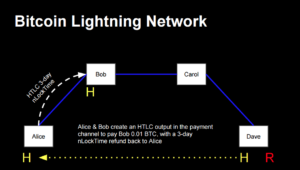 The ability of Bitcoin to provide distributed ledgers is what makes it secure and decentralized, as expected of any cryptocurrency. However, as a payment platform, Bitcoin is faced with limitations regarding its aspiration for a worldwide coverage of commerce. Bitcoin has a recurrent problem with reaching its capacity, leading to costly transaction fees and protracted settle times. This is because Bitcoin’s protocol requires every state alteration to the ledger to be broadcasted to every participant. Through this process, the balance of every participant is agreed upon as state consensus. This becomes excessively time- and data-intensive as every transaction occurring globally is tracked in the bitcoin network by each node. Such a setup will be far from competitive with other established payment networks such as Visa in the near future. This is where Bitcoin Lightning Network (BLN), the brainchild of Joseph Poon and Tadge Dryja, comes in.
The ability of Bitcoin to provide distributed ledgers is what makes it secure and decentralized, as expected of any cryptocurrency. However, as a payment platform, Bitcoin is faced with limitations regarding its aspiration for a worldwide coverage of commerce. Bitcoin has a recurrent problem with reaching its capacity, leading to costly transaction fees and protracted settle times. This is because Bitcoin’s protocol requires every state alteration to the ledger to be broadcasted to every participant. Through this process, the balance of every participant is agreed upon as state consensus. This becomes excessively time- and data-intensive as every transaction occurring globally is tracked in the bitcoin network by each node. Such a setup will be far from competitive with other established payment networks such as Visa in the near future. This is where Bitcoin Lightning Network (BLN), the brainchild of Joseph Poon and Tadge Dryja, comes in.
Bitcoin Lightning Network
BLN is envisioned to make bitcoin transactions faster and cheaper. BLN combines a routing protocol with a settlement protocol. It is built as a distinct network on top of existing blockchains. BLNs are largely designed to facilitate micropayments or lower-value transactions. The goal is to enable infinite number of almost-instant and virtually costless transactions.
How does Bitcoin Lightning Network Work?
BLN is located externally to the main bitcoin network, stopping each transaction from instant broadcast to the Bitcoin network. Nets of transactions are only broadcast on the blockchain, once users have aggregated transactions in their local drives and when an agreed time has passed or when there is a disagreement among users in the network.
The main element of BLN is a payment channel. The payment channel serves as a link between two network users. Users need to create a payment channel by opening and funding a shared account on the blockchain. This enables the users to conduct and accumulate transactions between the two without the need to broadcast immediately to the network. This is achieved by the provision of auto-executing smart contracts, double-spend security and time-locks – features that prevent any party from altering transaction history.
The first step is funding wherein two users establish a channel, specifying the total value of transactions. User A and user B will send an amount over the blockchain to a multi-sig or multi-signature Bitcoin address. A mult-sig address is like a lock wherein a set of predefined keys are needed for it to be unlocked.
Next is setting up the transaction which is achieved by having each user state the amount and address of payment. This can be repeated several times and can only be completed by adding each other’s signature on the transaction. The complete transaction can then be broadcasted to the whole network of bitcoin users.
The last step is closing the payment channel, which is when users agree to end the overall transaction. The channel can also be closed when the time set during its creation has expired. Bitcoin users will then be notified of the current state of the payment channel. Only the opening and closing of the transaction will appear on the Bitcoin blockchain.
In summary, a very technical and complex system lies underneath the simplified descriptions of BLN presented here. The takeaway point is that BLN allows participants an unlimited number of rapid transactions without cost and only two blockchain transactions for a cheaper fee than current rates.



